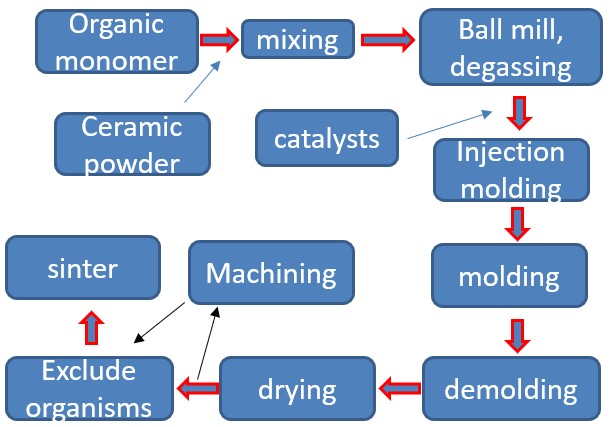
Privacy statement: Your privacy is very important to Us. Our company promises not to disclose your personal information to any external company with out your explicit permission.
Gel injection molding is a new ceramic molding technique that was invented in recent years. Some structural Ceramic Components have been used in the process. This method is, first of all, to disperse the ceramic powder in a solution containing organic monomers, prepare a suspension with a high solid phase volume fraction (>50%), and then inject it into a mold of a particular shape, under certain catalytic and temperature conditions, the organic monomer polymerizes, the system gels, resulting in the suspension solidifying in situ, and finally after drying can obtain a higher strength of the body. When changing from liquid to solid, the blank does not shrink or shrink very little, and the amount of medium does not change. It can manufacture complex-shaped Ceramic parts at net size, with good body uniformity and high strength. Its operation process is simple; the content of organic matter impurities in the body is small, and the ceramic-sintered body has excellent performance.
Gel injection molding is divided into two categories: water-soluble and non-water-soluble. The former is suitable for most ceramic molding applications, while the latter is mainly suitable for molding systems that react with water.

(1) Strong ability to apply ceramic powder, no special requirements for powder;
(2) Near-net size molding can be realized, large-size and complex shapes and wall thickness parts can be prepared, and a variety of materials can be selected for the mold;
(3) The molding cycle is short, and the wet blank and dry blank strength is high, which is better than the blank made by the traditional molding process, and can be mechanically processed;
(4) Low content of organic matter in the body;
(5) Good uniformity of the performance of the blank and sintered body;
(6) The process is easy to control;
(7) The process and operation are relatively simple, the equipment is simple, and the cost is low.
(1) Defects such as bubbles and cracks may occur during the molding and drying process;
(2) Toxicity of organic monomers.
Apply for:
Coarse particle system ceramics, advanced refractory materials, ceramic composites, structural ceramics, high precision structural ceramic components, functional and bioceramics, porous materials, and powder metallurgy.
January 19, 2022
January 03, 2017
December 09, 2023
August 12, 2022
November 06, 2024
November 07, 2024
As the microstructure of the surface of advanced ceramic materials is different from the metal materials, brazing often does not happen from ceramic to metal to bond them directly. Therefore, the...
1. In the raw materials, it breaks through the boundary of traditional ceramics with clay as the main raw material. Special ceramics generally use oxides, nitrides, silicides, borides and carbides as...
Oxygen evolution reaction (OER) is an important half-reaction in energy conversion and storage devices such as electrolysis of water and secondary metal-air batteries. However, OER has a high...
With the continuous development of science and technology, the progress of industrial ceramics has also made many breakthroughs,especially the research and development of multiphase composite...
Email to this supplier
January 19, 2022
January 03, 2017
December 09, 2023
August 12, 2022
November 06, 2024
November 07, 2024

Privacy statement: Your privacy is very important to Us. Our company promises not to disclose your personal information to any external company with out your explicit permission.

Fill in more information so that we can get in touch with you faster
Privacy statement: Your privacy is very important to Us. Our company promises not to disclose your personal information to any external company with out your explicit permission.